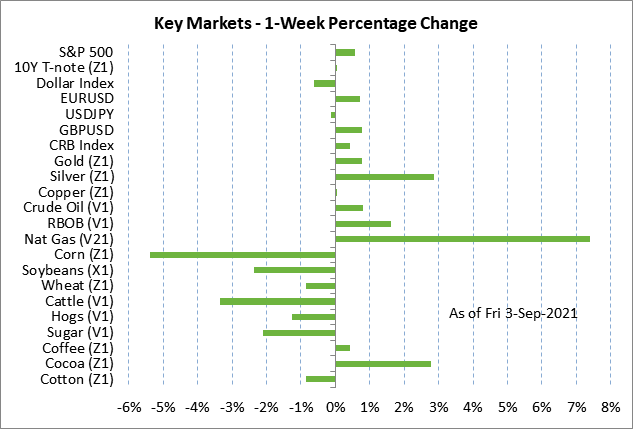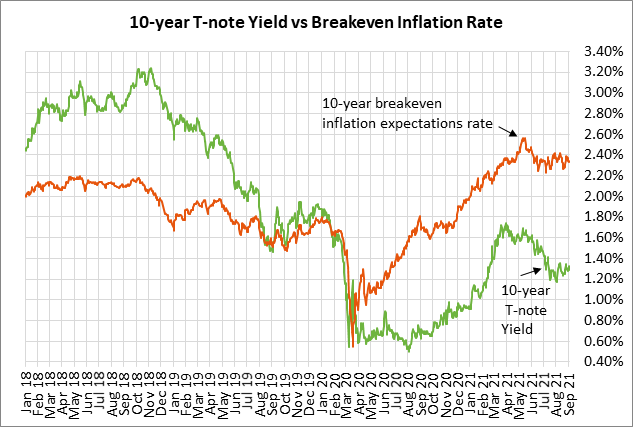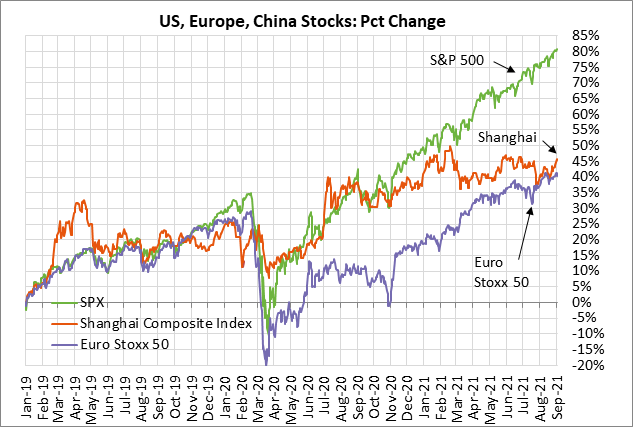- Weekly market focus
- Congressional lull lasts only another week
- Markets wait to see if a QE tapering announcement will come at the FOMC meeting in two weeks
Weekly market focus — The U.S. markets this week will focus on (1) whether the U.S. Covid infection levels start to level off, (2) further analysis of the timing of the Fed’s QE tapering, (3) the return of Congress over the next two weeks when they will need to work on the continuing resolution, a debt ceiling hike, the $550 billion bipartisan infrastructure bill, and the Democrat’s $3.5 trillion spending bill, (4) the Treasury’s sale of 3, 10 and 30-year securities on Tuesday through Thursday, and (5) the August U.S. inflation reports with the PPI report this Friday and the CPI report next Tuesday.



Congressional lull lasts only another week — Congress will remain in recess this week, but the Senate will return to session next Monday (Sep 13) and the House will return the following Monday (Sep 20). House Committees will be working from this Thursday through next Tuesday.
When Congress returns to Washington over the next two weeks they have a deluge of legislation to consider. The first order of business will be to try to keep the government open when the new fiscal year begins on October 1. Congress has not passed spending bills for the new fiscal year and must therefore approve a continuing resolution to keep the government running past October 1.
Congress has a little more time for a debt ceiling hike since the Congressional Budget Office has said that the Treasury will not hit its X-date until October or November. However, when the Treasury hits its X-date and is out of cash, the Treasury will no longer be able to meet all its financial obligations and the threat will arise of a sovereign debt default, which would be catastrophic.
Congress will most likely avert a sovereign debt default, but not until they engage in their usual brinkmanship that could test the market’s patience.
Republicans have said they will take no part in raising the debt ceiling. The only way that Democrats can get a debt ceiling past a Senate Republican filibuster is by including a debt ceiling hike in the reconciliation bill. However, a reconciliation bill might not be ready before the Treasury’s X-date.
Also, Democrats want to force the Republicans to help pass a debt ceiling because Democrats don’t want to take all the blame for the debt that has been racked up in recent years. In short, Democrats plan to force a showdown with Republicans over raising the debt ceiling, which is likely to cause market angst.
Meanwhile, House Speaker Pelosi promised her moderate wing that she will hold a vote on the $550 billion bipartisan infrastructure bill by September 27, which is now less than three weeks away. It seems likely that the House will pass a different version than the Senate, which means that the bill would be passed back to the Senate for reconsideration or possibly to a joint House-Senate conference.
Ms. Pelosi will try to avoid final passage of the infrastructure bill until the Senate has passed the $3.5 trillion reconciliation bill that is currently being written. House Democrats need to hold the infrastructure bill as ransom to try to make sure that the moderate Senate Democrats (Machin, Sinema) pass the reconciliation bill. Most of the House Democratic caucus believes that if the House gives final approval to the infrastructure bill first, the reconciliation bill will never pass the Senate.
Markets wait to see if a QE tapering announcement will come at the FOMC meeting in two weeks — The markets are on guard for the possibility that the FOMC at its meeting in just two weeks on Sep 21-22 may officially announce its QE tapering.
Fed Chair Powell at the Jackson Hole conference on Aug 27 indicated that the conditions have been met for QE tapering. He said the Fed believes that the economy has now met the test of “substantial further progress” toward the Fed’s inflation objective and that the labor market has also made “good progress.”
He said that at the last FOMC meeting in late July, “I was of the view, as were most participants, that if the economy evolved broadly as anticipated, it could be appropriate to start reducing the pace of asset purchases this year.”
It remains unclear exactly when the Fed will announce QE tapering. In any case, the markets do not seem particularly worried and seem prepared to take the QE tapering in stride.
The markets were mainly pleased that Mr. Powell in his Aug 27 Jackson Hole comments went out of his way to stress that the beginning of QE tapering will not bring interest rate liftoff any closer. He said, “The timing and pace of the coming reduction in asset purchases will not be intended to carry a direct signal regarding the timing of interest rate liftoff, for which we have articulated a different and substantially more stringent test.”
He added, “We have said that we will continue to hold the target range for the federal funds rate at its current level until the economy reaches conditions consistent with maximum employment, and inflation has reached 2% and is on track to moderately exceed 2% for some time. We have much ground to cover to reach maximum employment, and time will tell whether we have reached 2% inflation on a sustained basis.
